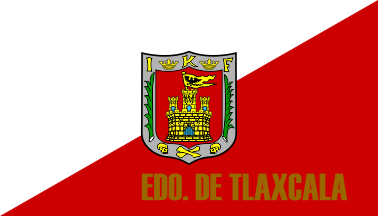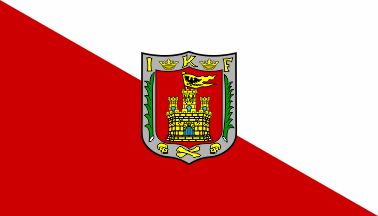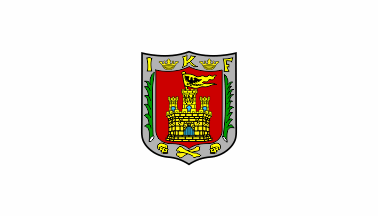![[Tlaxcala]](../images/m/mx-tl.gif)
![[State and civil flag]](../misc/ooxxxx.gif)
Officially recognized as state flag by Decree number 305 published on 30 December 2016, in force since 1 January 2017.
by Juan Manuel Gabino Villascán, 18 October 2014.

Last modified: 2019-12-21 by juan manuel gabino villascán
Keywords: mexico | tlaxcala | text |
Links: FOTW homepage |
search |
disclaimer and copyright |
write us |
mirrors
![[Tlaxcala]](../images/m/mx-tl.gif)
![[State and civil flag]](../misc/ooxxxx.gif)
Officially recognized as state flag by Decree number 305 published on 30 December 2016, in force since 1 January 2017.
by Juan Manuel Gabino Villascán, 18 October 2014.
![[Tlaxcala]](../images/m/mx-tl.gif)
![[State and civil flag]](../misc/ooxxxx.gif)
Officially recognized as state flag by Decree number 305 published on 30 December 2016, in force since 1 January 2017.
by Juan Manuel Gabino Villascán, 18 October 2014.

![[Reverse: Design of the reverse of two-sided flag.]](../misc/fis_reve.gif)
by Juan Manuel Gabino Villascán, 18 October 2014.
On 30 December 2016 was published the Decree 305, which in order to "support, encourage and promote the Patriotic Culture in the State of Tlaxcala", among other things states that:
The Decree is in force since 1 January 2017.
Juan Manuel Gabino Villascán, 20 December 2019
According article 10 of Decree 305 published on 30 December 2016 states that every 22 April, the review of the State Flag is published in the main State newspapers. Such a review is as follows:
"In 1981, after the proposal of Governor Tulio Hernández Gómez, Artist Desiderio Hernández Xochitiotzin designed the Flag of the State of Tlaxcala, which he would later paint on the mural called "The Golden Age of Tlaxcala", embodied on the central wall of the stairs cube connect the two floors of the Government Palace building. On30 October 2011 the Flag of Tlaxcala is recognized at the Municipality of Tlaxcala town hall as a symbol of both the State and the Municipality, and so stated in the Proclamation of Police and Good Governance of out entity's capital. Last Tlaxcalan governors have been the main supporters having promoted respect for the Flag of Tlaxcala as a symbol of the entity.
Our flag belongs to the State, which confirms the identity of all its inhabitants from the setting-up of the State until now, it should be noted that our flag does not involve any secession from the country.
The Flag of the State of Tlaxcala is divided by two diagonal stripes, one red and the other white, in the center the coat of arms of the State. These colors have represented the Republic of Tlaxcallan for standards and banners in such colors have been carried through.
Nowadays, although this Flag does not have legal recognition within the State Constitution, the Tlaxcalan population flies it at will to express its Tlaxcalanquity.
In the city of Tlaxcala de Xicohténcatl, official acts of the State Government are commemorated, where the Tlaxcalteca Flag appears for use and custom by both the state governor and the civilian population.
The State of Tlaxcala is an example to follow both in autonomy and sovereignty, having an identity of its own without quitting Mexican federalism."
From: e-tlaxcala.mx: Reseña histórica de la Bandera de Tlaxcala
Reporterd by Juan Manuel Gabino Villascán, 20 December 2019
A couple years ago I have read in the FOTW pages about some unidentified
diagonal red and white flag, said to have been seen in Veracruz by Spanish
officials while the King and Queen of Spain were visiting Mexico.
As long as I remember, FOTW said that it was seen in an indigenous town and
that it was flown as a salute to their majesties by the Indians.
Later I recognized the same flag in the murals of the State Government Hall
in Tlaxcala (State of Tlaxcala), in a rather unusual image depicting the four
Indian lords of Tlaxcala riding their horses side by side as allies with the
Spanish conqueror to battle against the Aztecs.
History tells us that Tlaxcala was the only Indian Mexican nation that
officially supported the Spaniards all along the conquest, since that
alliance helped Tlaxcala to get rid of the domination menace they suffered
from the Mexicas (or Aztecs, as they are better known), and let them get a
privileged treatment by the Spanish.
Tlaxcala and Mexico were long time enemies and Spanish conquest became an
excellent opportunity for Tlaxcala to vanquish the Aztecs. Since then,
Tlaxcala has been held as a 'traitor' nation by official Mexican historians.
Official Mexican history, teached in primary schools, tells that Aztecs were 'good', Spaniards were 'bad' and Tlaxcaltecas were 'traitors'. History teached in the State of Tlaxcala tells that Aztecs were conquerors, Spaniards were allies and that Tlaxcala won the war against Aztecs thanks to Spanish support. This is opposed to what pupils learn all around the rest of Mexico, but it is Tlaxcala's view of things.
So, and after asking a few historians, I think that red and white diagonal flag seems to represent some kind of allegiance from Indians towards the Spanish crown, at least in those regions Hernán Cortés crossed in his campaign against the Aztecs (Veracruz, Puebla and Tlaxcala). That flag had to be forbidden or, at least, 'secretly' flown, since that allegiance from the Indians towards the Spanish crown is officially excluded by Independent Mexican history. Indians and Spaniards officially had to be eternal enemies. This flag has had an important place only in the State of Tlaxcala (in the murals of State Hall, at least and as long as I know), and it is understandable that no Mexican officials (excepting those grown in Tlaxcala) would know anything about the flag and its significance. Now Tlaxcala has been governed for a few years by a left-wing opposition party, which has used a new State motto: "Cradle of the Nation".
Many people wonder why Tlaxcala should be considered the cradle of the Mexican nation (a privilege usually reserved to Mexico City, whose Aztec foundation is depicted in the national flag and coat of arms), but the explanation is that if Tlaxcala is not the cradle of the official Aztec 'Mexicanity', it is indeed the first place where Indians and Spaniards worked, battled and melted together to form the present Mexican mixed ethnics.
The real news is that this semi-clandestine red and white diagonal flag, but now with the addition of the State of Tlaxcala Coat of Arms in its center, has begun to fly openly in public buildings, industries and touristic facilities in the State of Tlaxcala. I do not know if it is official (I am sure Federal authorities would not like to authorize its use as a State Flag), I guess it is not, but I have been there just yesterday and I have seen it flying almost everywhere.
Gerardo Francisco Kloss Fernandez del Castillo, May 27, 2003
The state flag has not been adopted officially by any act, law or decree. Nevertheless is has given official recognition by the municipalities of Tlaxcala de Xicotencatl and Contla de Juan Cuamatzi.
It is flown in official buildings, schools and squares. It is hoisted during public holidays and given honors just after the national flag.
Juan Manuel Gabino Villascán 18 October 2014.
.gif)
by Juan Manuel Gabino Villascán, 18 October 2014.
According article 10 of Decree 305 publised on 30 December 2016 states that every 22 April, the review of the State Flag is published in the main State newspapers. Such a rewiew is as follows:
"The coat of arms was granted by royal decree issued in Madrid, on 22 April 1535, as a response from the Crown of Spain to the request of Ocotelulco Governor Diego Maxicatzin on behalf of the city of Tlaxcala. The document was written on a scroll.
The castle of gold on red is the heraldic image of Castile representing the Castilian fortresses built-up to resist the advance of the Moors on the peninsula and the blood of the infidels shed on the battlefields during the so-called Spanish Reconquest. As the main image of the Tlaxcala coat of arms, it represents the city as a new Castile, victor against the Mexica during the Conquista.
The black eagle on gold is the heraldic image of the Holy German Roman Empire and, therefore, it is a representation of Emperor Charles V, who granted the coat of arms. The silver border represents the Catholic faith, which the Tlaxcaltecs embraced without opposition.
The initials correspond to those of the Latinized names of Queen Joanna of Castile, Emperor Charles V and then Prince Philip. The two crowns represent Queen Joanna, head of the Castilian Crown, and Charles V as co-owner of the same Crown.
Palms are a symbol of victory, in this case over the Mexica. The skulls are trophies and would represent the dead Mexica during the capture of Tenochtitlan in 1521."
From: e-tlaxcala.mx: Reseña histórica de la Bandera de Tlaxcala
Reporterd by Juan Manuel Gabino Villascán, 20 December 2019
The arms consist on a "French style" green-bordered red shield. It bears a yellow castle
resembling Castile (Spain) whose flag over the main tower shows the Austrian arms.
Over the border, at the top corners there are two golden initials "I" and "F" for the
Catholic Kings of Spain, Isabel (Elizabeth) and Fernando (Ferdinand) respectively;
between them the letter "K", also golden, for Karolus (Charles I of Spain and V of Germany)
who granted to Tlaxcala such arms; in both side two leaves, and in the bottom two
skulls and two crossed bones.
Juan Manuel Gabino Villascán, 12 October 2001

by Juan Manuel Gabino Villascán, 18 October 2014.
Though the flag is actually flown bearing the state's name in gold, some flags, specially those desk-made or small-sized ones, bear no text at all.
Juan Manuel Gabino Villascán 18 October 2014.

![[State flag]](../misc/xoxxxx.gif) |
|
![[Alternate version of the flag. One of two or more flags that may be used, in general or under certain circumstances, for the same function.]](../misc/fis_alte.gif) |
|
![[Design is an acceptable variant]](../misc/fis_vari.gif)
by Juan Manuel Gabino Villascán, 18 October 2014.
In federal circles or official events outside Tlaxcala, the white flag with the state coat of arms is used.
Juan Manuel Gabino Villascán 18 October 2014.
Anything below this line was not added by the editor of this page.